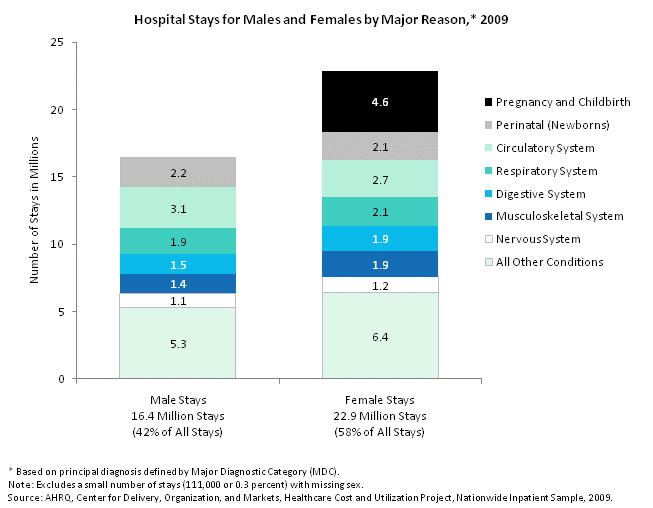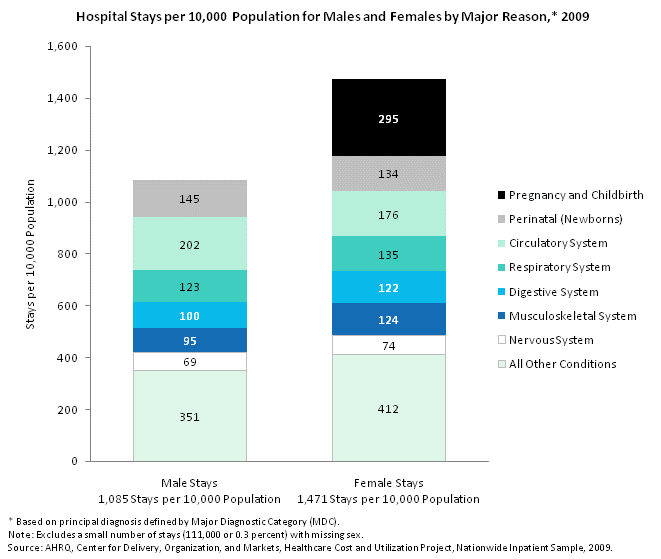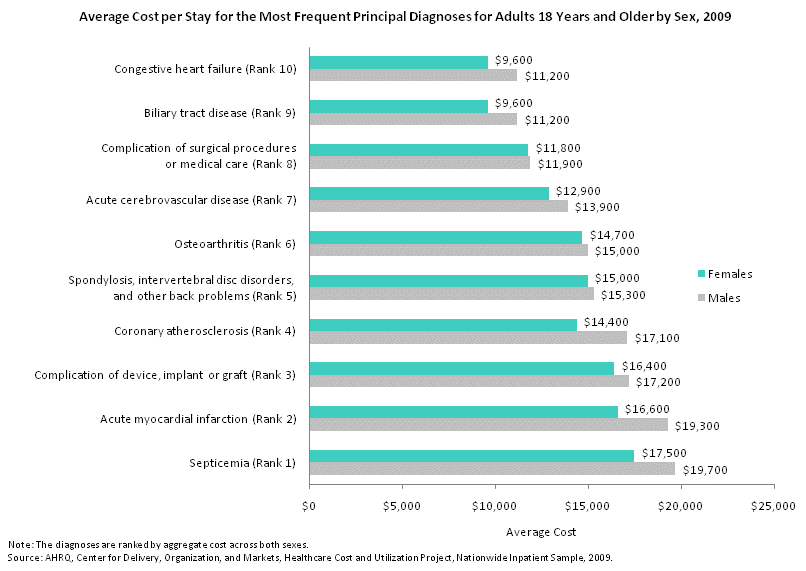TABLE OF CONTENTS
HIGHLIGHTS
INTRODUCTION
HCUP PARTNERS
1. OVERVIEW
2. DIAGNOSES
3. PROCEDURES
4. COSTS
5. WOMEN'S HEALTH
SOURCES/METHODS
DEFINITIONS
FOR MORE INFO
ACKNOWLEDGMENTS
CITATION
FACTS & FIGURES 2009 PDF
|
EXHIBIT 5.2 Common Conditions During Hospital Stays for Females (PDF)
5.2a 
Hospital stays for males and females by major reason, 2009. Column chart. Number of stays in millions. Male stays. Total stays: 16.4. 42% of all stays. Perinatal (newborns): 2.2; circulatory system: 3.1; respiratory system: 1.9; digestive system: 1.5; musculoskeletal system: 1.4; nervous system: 1.1; all other conditions: 5.3. Female stays. Total stays: 22.9. 58% of all stays. Pregnancy and childbirth: 4.6; perinatal (newborns): 2.1; circulatory system: 2.7; respiratory system: 2.1; digestive system: 1.9; musculoskeletal system: 1.9; nervous system: 1.2; all other conditions: 6.4. Note: Reasons based on principal diagnosis defined by Major Diagnostic Category (MDC). Note: Excludes a small number of stays (111,000 or 0.3%) with missing sex. Source: AHRQ, Center for Delivery, Organization, and Markets, Healthcare Cost and Utilization Project, Nationwide Inpatient Sample, 2009.
- Giving birth (mothers) or being born (infants) accounted for 8.9 million hospitalizations in 2009, about 23 percent of all hospital stays.
- Males accounted for 16.4 million hospitalizations, while females experienced 22.9 million stays.
- When stays for pregnancy and childbirth are excluded, circulatory conditions were the most frequent cause of hospital stays for both males and females in 2009, accounting for 5.8 million stays. Circulatory conditions accounted for 19 percent of male stays and 12 percent of female stays.
- Excluding pregnancy and childbirth, the largest sex differences in reasons for hospitalization were for diseases of the musculoskeletal system (1.9 million female versus 1.4 million male stays).
- Even when pregnancy and childbirth stays are excluded, females accounted for more stays than males — 18.3 million stays for females compared to 16.4 million stays for males.
5.2b 
Hospital stays per 10,000 population for males and females by major reason, 2009. Column chart. Stays per 10,000 population. Male stays. Total stays: 1,085. Perinatal (newborns): 145; circulatory system: 202; respiratory system: 123; digestive system: 100; musculoskeletal system: 95; nervous system: 69; all other conditions: 351. Female stays. Total stays: 1,471. Pregnancy and childbirth: 295; perinatal (newborns): 134; circulatory system: 176; respiratory system: 135; digestive system: 122; musculoskeletal system: 124; nervous system: 74; all other conditions: 412. Note: Reasons based on principal diagnosis defined by Major Diagnostic Category (MDC). Note: Excludes a small number of stays (111,000 or 0.3%) with missing sex. Source: AHRQ, Center for Delivery, Organization, and Markets, Healthcare Cost and Utilization Project, Nationwide Inpatient Sample, 2009.
- Males experienced 1,085 stays per 10,000 population, while females experienced 1,471 stays per 10,000 population.
- Even when pregnancy and childbirth stays are excluded, the rate of hospitalizations for females was higher than that for males—1,176 stays per 10,000 population for females compared to 1,085 stays per population for males.
- Giving birth or being born accounted for 289 stays per 10,000 population in 2009 (rate is for the total population; data not shown).
- Excluding pregnancy and childbirth, the largest sex differences in reasons for hospitalization were for diseases of the musculoskeletal system (124 stays per 10,000 population for females versus 95 stays per 10,000 population for males) and digestive system (122 stays per 10,000 females versus 100 stays per 10,000 males).
- Among male non-newborn stays, circulatory conditions had the highest rate of stays (202 per 10,000 population), followed by respiratory conditions (123 per 10,000 population).
- For females, the rate of stays for pregnancy and childbirth (295 per 10,000 population) was higher than for any other condition. Circulatory conditions (176 per 10,000 population) and respiratory system conditions (135 per 10,000 population) were other major reasons for female hospitalizations.
- Respiratory system conditions were more common for females (135 per 10,000 population) than for males (123 per 10,000 population).
5.2c
Number of Stays and Stays per 10,000 Population for the Most Frequent Principal Diagnoses for Hospital Stays, Adults 18 Years and Older by Sex, 2009
| PRINCIPAL CCS DIAGNOSIS |
NUMBER OF STAYS IN THOUSANDS |
STAYS PER 10,000 POPULATION |
| MALES |
FEMALES |
MALES |
FEMALES |
| All stays* |
13,240 |
19,814 |
1,168 |
1,663ξ |
| Female rates higher than male rates |
| Pneumonia |
473 |
532 |
42 |
45ξ |
| Osteoarthritis |
363 |
555 |
32 |
47ξ |
| Mood disorders |
346 |
439 |
31 |
37ξ |
| Chronic obstructive pulmonary disease and bronchiectasis |
322 |
407 |
28 |
34ξ |
| Non-specific chest pain |
318 |
380 |
28 |
32ξ |
| Urinary tract infections |
152 |
392 |
13 |
33ξ |
| Complication of surgical procedures or medical care |
228 |
265 |
20 |
22ξ |
| Biliary tract disease |
168 |
298 |
15 |
25ξ |
| Male rates higher than female rates |
| Coronary atherosclerosis |
520 |
311 |
46 |
26ξ |
| Complication of device, implant or graft |
331 |
315 |
29 |
26ξ |
| Acute myocardial infarction |
383 |
250 |
34 |
21ξ |
| Skin and subcutaneous tissue infections |
296 |
266 |
26 |
22ξ |
| Diabetes mellitus with complications |
265 |
237 |
23 |
20ξ |
| Female rates not statistically different from male rates |
| Septicemia |
389 |
426 |
34 |
36 |
| Cardiac dysrhythmias |
397 |
405 |
35 |
34 |
| Congestive heart failure |
508 |
514 |
45 |
43 |
| Spondylosis, intervertebral disc disorders, and other back problems |
311 |
337 |
27 |
28 |
| Acute cerebrovascular disease |
262 |
287 |
23 |
24 |
| Female-specific diagnoses |
| Trauma to vulva and perineum due to childbirth |
- |
721 |
- |
60 |
| Maternal stay with previous C-section |
- |
539 |
- |
45 |
* Excludes a small number of stays (111,000 or 0.3 percent) with missing sex.
ξ Female stays per 10,000 population are statistically different from male stays per 10,000 population at p<0.05.
Source: AHRQ, Center for Delivery, Organization, and Markets, Healthcare Cost and Utilization Project, Nationwide Inpatient Sample, 2009.
|
This table focuses on the top 20 most common conditions treated in U.S. hospitals. Diagnoses related to childbirth, including trauma to vulva and perineum due to childbirth and maternal stay with previous C-section, occurred more frequently than other diagnoses. If childbirth is excluded, most diagnoses were common to both males and females, although there were some differences by sex.
Females had a higher rate of stays than males for several conditions:
- Urinary tract infections were about 2.5 times greater for females than males.
- Biliary tract disease occurred at a 67-percent higher rate in females than males.
- Osteoarthritis occurred at a 47-percent higher rate in females than males.
- Chronic obstructive pulmonary disease occurred at a 21-percent higher rate in females than males.
- Mood disorders occurred at a 19-percent higher rate in females than males.
- Non-specific chest pain occurred at a 14-percent higher rate in females than males.
- Complication of surgical procedures or medical care occurred at a 10-percent higher rate in females than males.
Males had a higher rate of stays than females for the following conditions:
- Coronary atherosclerosis occurred at a 77-percent higher rate among males than females.
- Acute myocardial infarction occurred at a 62-percent higher rate among males than females.
- Skin and subcutaneous tissue infections occurred at an 18-percent higher rate among males than females.
- Diabetes mellitus with complications occurred at a 15-percent higher rate among males than females.
- Complication of device, implant, or graft occurred at a 12-percent higher rate among males than females.
Females and males had a similar rate of stays for several conditions:
- Septicemia (36 and 34 stays per 10,000 female and male population, respectively).
- Congestive heart failure (43 and 45 stays per 10,000 female and male population, respectively).
- Cardiac dysrhythmias (34 and 35 stays per 10,000 female and male population, respectively).
Five heart-related diagnoses were among the twenty most common principal inpatient diagnoses for both males and females:
- Congestive heart failure, coronary atherosclerosis, cardiac dysrhythmias, non-specific chest pain, and acute myocardial infarction.
Infections such as septicemia, skin and subcutaneous tissue infections, and urinary tract infections were common reasons for hospital stays among both males and females in 2009.
5.2d 
Average cost per stay for the most frequent principal diagnoses for adults 18 years and older by sex, 2009. Bar chart. Average cost. Septicemia (Rank 1). Females: $17,500; males: $19,700. Acute myocardial infarction (Rank 2). Females: $16,600; males: $19,300. Complication of device, implant or graft (Rank 3). Females: $16,400; males: $17,200. Coronary atherosclerosis (Rank 4). Females: $14,400; males: $17,100. Spondylosis, intervertebral disc disorders, and other back problems (Rank 5). Females: $15,000; males: $15,300. Osteoarthritis (Rank 6). Females: $14,700; males: $15,000. Acute cerebrovascular disease (Rank 7). Females: $12,900; males: $13,900. Complication of surgical procedures or medical care (Rank 8). Females: $11,800; males: $11,900. Biliary tract disease (Rank 9). Females: $9,600; males: $11,200. Congestive heart failure (Rank 10). Females: $9,600; males: $11,200. Note: The diagnoses are ranked by aggregate cost across both sexes. Source: AHRQ, Center for Delivery, Organization, and Markets, Healthcare Cost and Utilization Project, Nationwide Inpatient Sample, 2009.
Average costs per stay for the most frequent principal diagnoses were either lower for females or were similar for males and females.
- Hospital stays for four cardiovascular conditions—congestive heart failure, acute cerebrovascular disease, coronary atherosclerosis, and acute myocardial infarction—cost less for females than for males.
- Stays for septicemia and biliary tract disease were also less expensive for females than for males.
- Average costs were similar for females and males for stays involving complication of device, implant or graft; osteoarthritis; spondylosis; and complication of surgical procedures or medical care.
Previous Next
|


